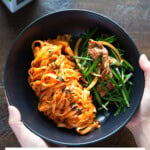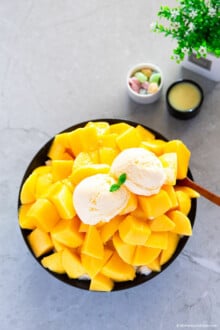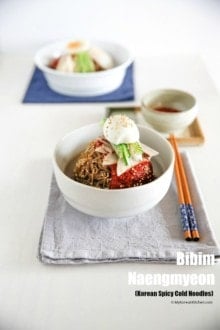Try this Kal Bibimmyeon with Chadolbaegi Salad! I was inspired by one of the popular menu items at 익선애뜻 (Ikseonaetteot), an Instagram-popular Korean restaurant in Seoul. Even though I haven’t had the chance to try this dish firsthand yet, I was captivated by their presentation, and my imagination has pieced together a sensory experience that brings it to life in this recipe.
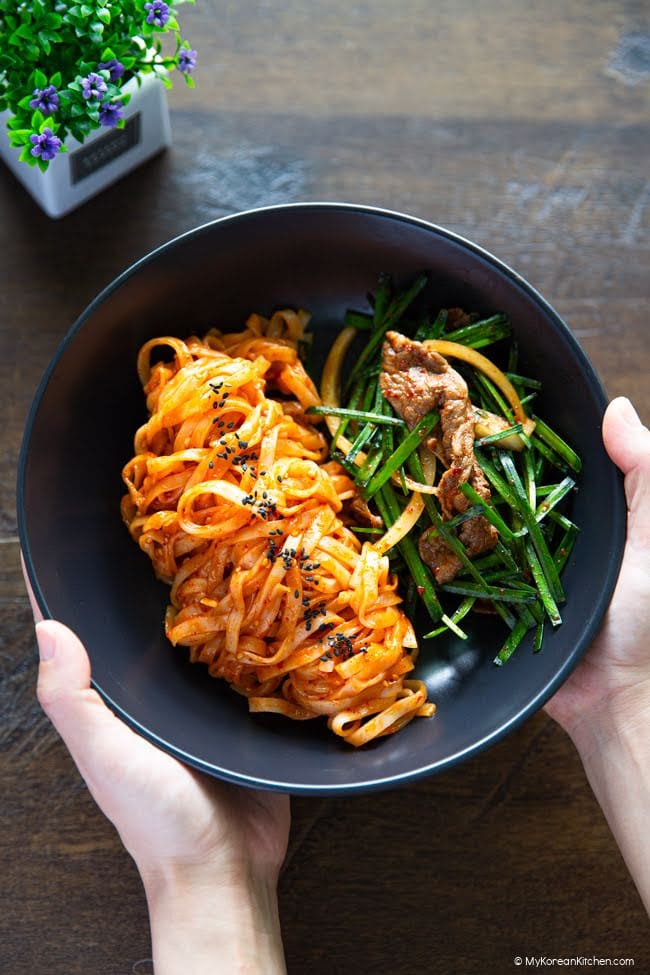
This gourmet delight masterfully fuses noodles, salad, and meat, featuring thinly shaved chadolbaegi, or beef brisket, seared to juicy perfection. Fragrant garlic chives add a refreshing contrast to the rich beef, all enhanced by a delicious dressing made with authentic Korean seasonings. The knife-cut noodles provide a chewy texture, perfectly soaking up the bold, spicy sauce, making every bite a satisfying blend of heat and zest.
Simply put, this dish combines two main components into one, allowing you to enjoy each element on its own or intertwine the noodles with the salad—whichever suits your taste.
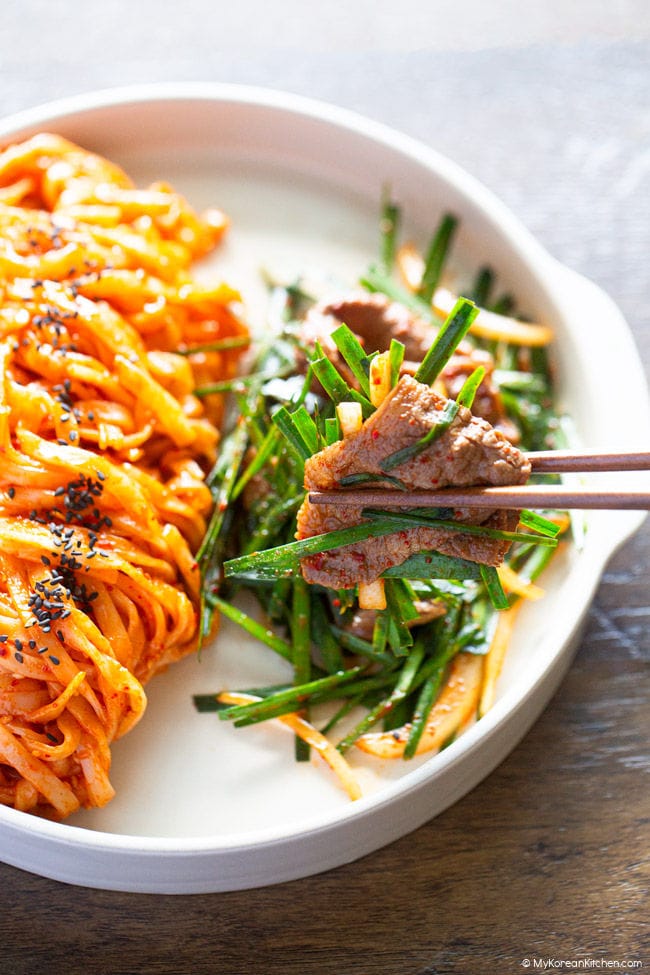
Handy Tips for Success
Thinly sliced brisket is readily available at most Korean grocery stores or K-butchers, with each slice measuring 0.1 to 0.2 cm (0.04 to 0.08 inches). I highly recommend getting this cut to save time and effort.
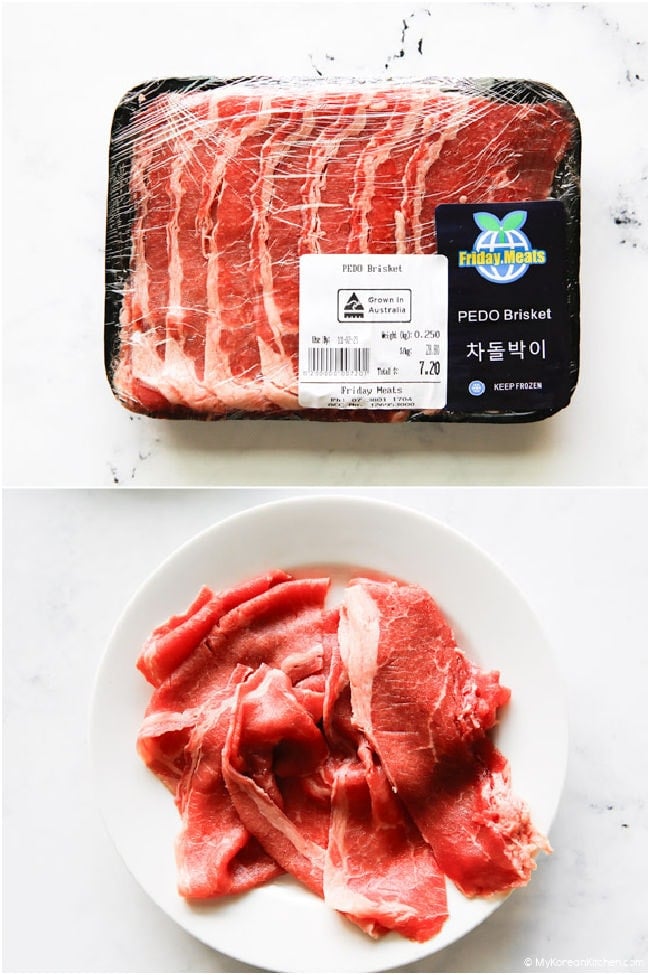
If you prefer to slice it yourself, opt for a PEDO (point end deckle off) brisket. I noticed some butchers sell it online. Lightly freezing the brisket will firm up its shape, making it easier to shave, or fully freeze it if you’re using a meat slicer.
If you can’t find PEDO brisket but can get a whole brisket, you can still make it work. Cut the brisket into sections (flat, point, etc.) and look for the slightly fattier area (point end), as not all brisket parts are suitable for the chadolbaegi cut. Remove the deckle. Lightly freeze the meat to firm up its shape for easier shaving, or fully freeze it if you’re using a meat slicer.
Please note that I haven’t done the DIY chadolbaegi cut myself; this is based on my research. However, I intend to try it myself one day.
Ingredients
Main
- 100g / 3.5 ounce Korean beef brisket (chadolbaegi, 차돌박이), thinly slice or shave if not already prepared
- some cooking oil (such as rice bran oil, canola oil)
- 45g / 1.6 ounce garlic chives, rinsed, cut in 5 cm / 1.97 inch length
- 25g / 0.9 ounce onion, thinly sliced
- 200g / 7.1 ounce knife cut noodles (kalguksu noodles)
Salad Dressing
- 2 tsp raw sugar
- 2 tsp soy sauce, regular (such as Kikkoman brand – naturally brewed, or Korean yangjo ganjang)
- 2 tsp rice wine vinegar
- 1 tsp Korean fish sauce
- 1 tsp gochugaru (Korean chili flakes)
Bibimmyeon Sauce
- 2 Tbsp gochujang (Korean chili paste)
- 1 Tbsp honey
- 1 Tbsp raw sugar
- 1 Tbsp sesame seeds
- 1 Tbsp apple cider vinegar
- 1/2 Tbsp gochugaru (Korean chili flakes)
- 1/2 Tbsp sesame oil
* 1 Tbsp = 15 ml, 1 cup = 250 ml
** If you want to learn more about Korean ingredients, check out my essential Korean ingredients list.
How To Make
1. Prepare two flavorful sauces: the Salad Dressing and the Bibimmyeon Sauce. Mix each in a separate bowl and set them aside.
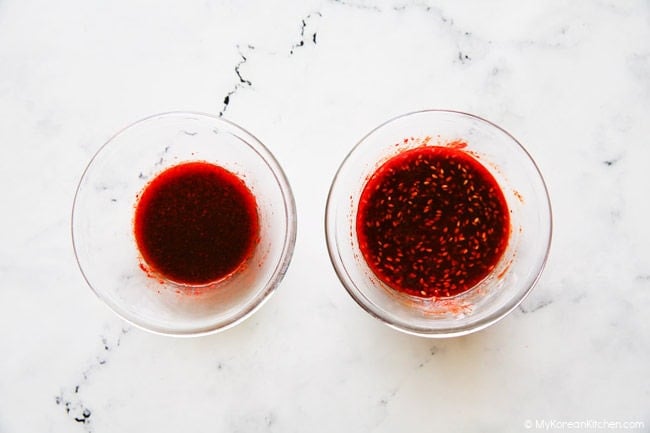
2. Preheat a skillet over medium heat and add a splash of cooking oil. When the oil is hot, add the brisket and cook until lightly browned and tender. – I prefer my meat cooked to medium to medium-well.

3. In a medium-sized bowl, combine the garlic chives, onion, cooked brisket, and the garlic chives sauce. Mix well to meld the flavors.

4. Bring a pot of water to a boil. Once boiling, add the kalguksu noodles and cook until tender, following the package instructions. Drain the noodles, rinse them in cold water, and set aside.
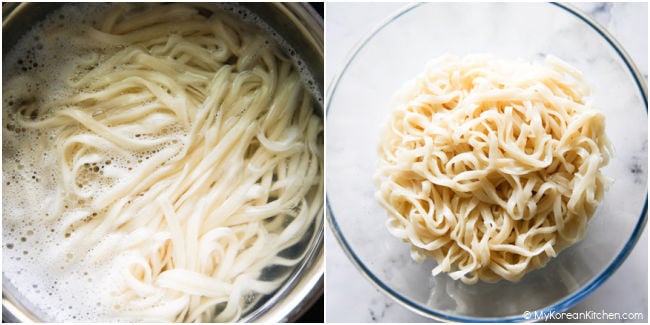
5. In a clean bowl, combine the cooked noodles with the bibimmyeon sauce. Toss until the noodles are thoroughly coated.
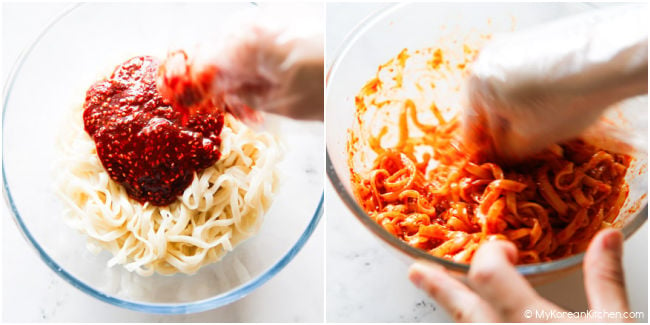
6. To serve, arrange the seasoned noodles alongside the brisket salad on a large plate. To eat, you can enjoy each component on its own or intertwine the noodles with the salad—whichever way suits your taste.
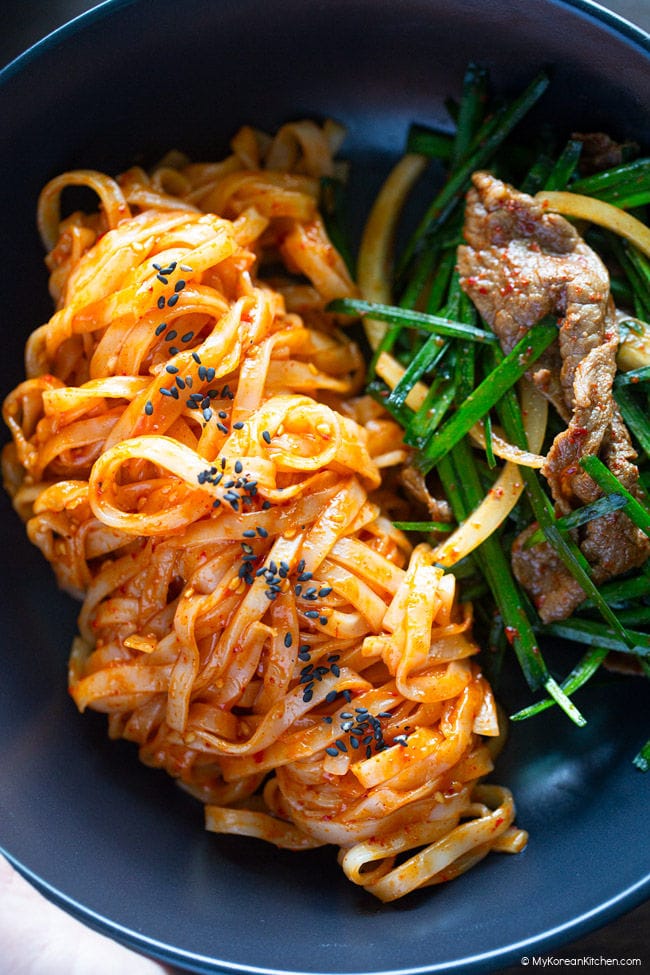
Other Delicious Kalguksu Noodle Recipes
- Kalguksu (Korean Knife Cut Noodle Soup)
- Dak Kalguksu (Korean Chicken Noodle Soup)
Love Korean food? Explore our site for more authentic Korean recipes including how to create a perfect Korean BBQ at home or other easy Korean recipes. Also, never miss a new recipe by subscribing to our newsletter, and join us in celebrating Korean cuisine!
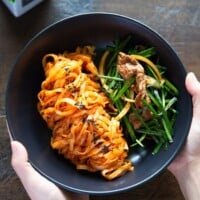
Kal Bibimmyeon with Chadolbaegi Salad
Ingredients
MAIN
- 100 g Korean beef brisket (chadolbaegi), (3.5 ounce), thinly slice or shave if not already prepared
- some cooking oil (such as rice bran oil, canola oil)
- 45 g garlic chives (1.6 ounce), rinsed, cut in 5 cm / 1.97 inch length
- 25 g onion (0.9 ounce), thinly sliced
- 200 g knife cut noodles (kalguksu noodles), (7.1 ounce)
SALAD DRESSING
- 2 tsp raw sugar
- 2 tsp soy sauce , regular (such as Kikkoman brand – naturally brewed, or Korean yangjo ganjang)
- 2 tsp rice wine vinegar
- 1 tsp Korean fish sauce
- 1 tsp gochugaru (Korean chili flakes)
BIBIMMYEON SAUCE
- 2 Tbsp gochujang (Korean chili paste)
- 1 Tbsp honey
- 1 Tbsp raw sugar
- 1 Tbsp sesame seeds
- 1 Tbsp apple cider vinegar
- 1/2 Tbsp gochugaru (Korean chili flakes)
- 1/2 Tbsp sesame oil
Instructions
- Prepare two flavorful sauces: the Salad Dressing and the Bibimmyeon Sauce. Mix each in a separate bowl and set them aside.
- Preheat a skillet over medium heat and add a splash of cooking oil. When the oil is hot, add the brisket and cook until lightly browned and tender. – I prefer my meat cooked to medium to medium-well.
- In a medium-sized bowl, combine the garlic chives, onion, cooked brisket, and the garlic chives sauce. Mix well to meld the flavors.
- Bring a pot of water to a boil. Once boiling, add the kalguksu noodles and cook until tender, following the package instructions. Drain the noodles, rinse them in cold water, and set aside.
- In a clean bowl, combine the cooked noodles with the bibimmyeon sauce. Toss until the noodles are thoroughly coated.
- To serve, arrange the seasoned noodles alongside the brisket salad on a large plate. To eat, you can enjoy each component on its own or intertwine the noodles with the salad—whichever way suits your taste.
Notes
- Thinly sliced brisket is readily available at most Korean grocery stores or K-butchers, with each slice measuring 0.1 to 0.2 cm (0.04 to 0.08 inches). I highly recommend getting this cut to save time and effort.
- If you prefer to slice it yourself, opt for a PEDO (point end deckle off) brisket. I noticed some butchers sell it online. Lightly freezing the brisket will firm up its shape, making it easier to shave, or fully freeze it if you’re using a meat slicer.
- If you can’t find PEDO brisket but can get a whole brisket, you can still make it work. Cut the brisket into sections (flat, point, etc.) and look for the slightly fattier area (point end), as not all brisket parts are suitable for the chadolbaegi cut. Remove the deckle. Lightly freeze the meat to firm up its shape for easier shaving, or fully freeze it if you’re using a meat slicer. Please note that I haven’t done the DIY chadolbaegi cut myself; this is based on my research. However, I intend to try it myself one day.
Nutrition Info (per serving)
The nutrition information shown is an estimate provided by an online nutrition calculator. It should not be considered a substitute for a professional nutritionist’s advice.
